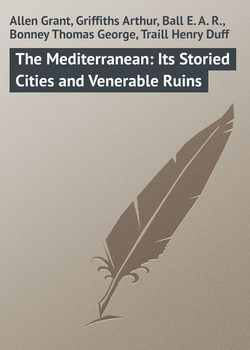The Mediterranean: Its Storied Cities and Venerable Ruins

Реклама. ООО «ЛитРес», ИНН: 7719571260.
Оглавление
Allen Grant. The Mediterranean: Its Storied Cities and Venerable Ruins
I. THE PILLARS OF HERCULES
II. ALGIERS
III. MALAGA
IV. BARCELONA
V. MARSEILLES
VI. NICE
VII. THE RIVIERA
VIII. GENOA
IX. THE TUSCAN COAST
X. VENICE
XI. ALEXANDRIA
XII. MALTA
XIII. SICILY
XIV. NAPLES
Отрывок из книги
“Algiers,” says the Arab poet, with genuine Oriental love of precious stones in literature, “is a pearl set in emeralds.” And even in these degenerate days of Frank supremacy in Islam, the old Moorish town still gleams white in the sun against a deep background of green hillside, a true pearl among emeralds. For it is a great mistake to imagine North Africa, as untravelled folk suppose, a dry and desert country of arid rocky mountains. The whole strip of laughing coast which has the Atlas for its backbone may rank, on the contrary, as about the dampest, greenest, and most luxuriant region of the Mediterranean system. The home of the Barbary corsairs is a land of high mountains, deep glens, great gorges; a land of vast pine forests and thick, verdant undergrowth. A thousand rills tumble headlong down its rich ravines; a thousand rivers flow fast through its fertile valleys. For wild flowers Algeria is probably unequaled in the whole world; its general aspect in many ways recalls on a smaller scale the less snow-clad parts of eastern Switzerland.
When you approach the old pirate-nest from the sea, the first glimpse of the African coast that greets your expectant eye is a long, serrated chain of great sun-smitten mountains away inland and southward. As the steamer nears the land, you begin, after a while, to distinguish the snowy ridge of the glorious Djurjura, which is the Bernese Oberland of Algeria, a huge block of rearing peaks, their summits thick-covered by the virgin snow that feeds in spring a score of leaping torrents. By-and-by, with still nearer approach, a wide bay discloses itself, and a little range of green hills in the foreground detaches itself by degrees from the darker mass of the Atlas looming large in the distance behind. This little range is the Sahel, an outlier just separated from the main chain in the rear by the once marshy plain of the Metidja, now converted by drainage and scientific agriculture into the most fertile lowland region of all North Africa.
.....
In the capital of Catalonia, twentieth-century civilization and the mediæval spirit may still be called next-door neighbors. The airy boulevards and handsome villas of suburban Algiers are not more strikingly contrasted with the ancient Moorish streets than the new quarters of Barcelona with the old. The Rambla, its electric lights, its glittering shops, cafés, clubs, and theaters, recalls a Parisian boulevard. In many of the tortuous, malodorous streets of the old town there is hardly room for a wheelbarrow to be drawn along; no sunbeam has ever penetrated the gloom.
On the Sunday morning following the Festival of All Saints – the 4th of November – the splendid old cathedral was the scene of a veritable pageant. Wax lights illuminated the vast interior from end to end, the brocades and satins of priestly robes blazed with gold embroidery, the rich adornments and treasure of altar and chapels could be seen in full splendor. Before the grand music of the organ and the elevation, a long, very long, sermon had to be listened to, the enormous congregation for the most part standing; scattered groups here and there squatted on the stone piers, not a chair to be had anywhere, no one seeming to find the discourse too long. When at last the preacher did conclude, the white-robed choristers, men and boys, passed out of the choir, and formed a double line. Then the bishop in solemn state descended from the high altar. He wore a crimson gown with long train borne by a priest, and on his head a violet cap, with pea-green tuft. The dresses of the attendant clergy were no less gorgeous and rich in texture, some of crimson with heavy gold trimmings, others of mauve, guinea-gold, peach color, or creamy white, several wearing fur caps. The procession made the round of the choir, then returned to the starting-point. As I sat behind the high altar on one of the high-backed wooden benches destined for the aged poor, two tiny chorister boys came up, both in white surplices, one with a pink, the other with sky-blue collar. Here they chatted and laughed with their hands on the bell-rope, ready to signal the elevation. On a sudden the tittering ceased, the childish hands tugged at the rope, the tinkling of the bell was heard, and the multitude, as one man, fell on its knees, the organ meantime being played divinely. Service over, the crowds emerged into the dazzling sunshine: pleasure parties, steamboat trips, visits, theaters, bull-fights occupied the rest of the day, the Rambla presenting the appearance of a masquerade.
.....